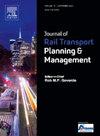A review of train delay prediction approaches
Abstract
Railway operations are vulnerable to delays. Accurate predictions of train arrival and departure delays improve the passenger service quality and are essential for real-time railway traffic management to minimise their further spreading. This review provides a synoptic overview and discussion covering the breadth of diverse approaches to predict train delays. We first categorise research contributions based on their underlying modelling paradigm (data-driven and event-driven) and their mathematical model. We then distinguish between very short to long-term predictions and classify different input data sources that have been considered in the literature. We further discuss advantages and disadvantages of producing deterministic versus stochastic predictions, the applicability of different approaches during disruptions and their interpretability. By comparing the results of the included contributions, we can indicate that the prediction error generally increases when broadening the prediction horizon. We find that data-driven approaches might have the edge on event-driven approaches in terms of prediction accuracy, whereas event-driven approaches that explicitly model the dynamics and dependencies of railway traffic have their strength in providing interpretable predictions, and are more robust concerning disruption scenarios. The growing availability of railway operations data is expected to increase the appeal of big-data and machine learning methods.

 求助内容:
求助内容: 应助结果提醒方式:
应助结果提醒方式:


